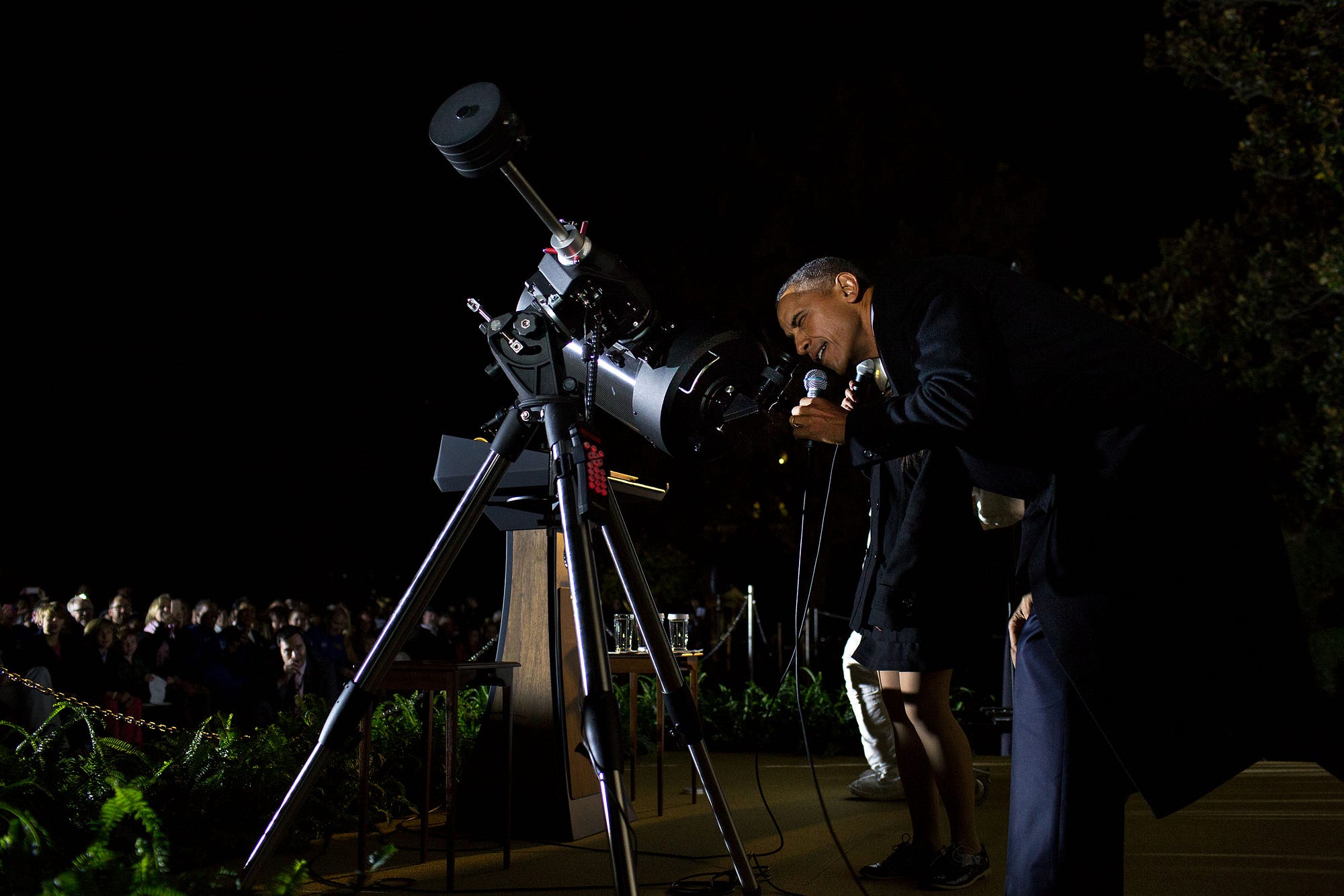President Obama Hosts Frontiers Conference, Focusing on the Potential of Science, Technology, and Innovation to Drive Prosperity and Address Challenges in Personal, Local, National, Global, and Interplanetary Frontiers for the Next 50 Years and Beyond
President Barack Obama looks at the moon through a telescope while talking with student Agatha Sofia “Sofy” Alvarez Bareiro during White House Astronomy Night on the South Lawn of the White House, Oct. 19, 2015. (Official White House Photo by Pete Souza)
Washington, DC–(ENEWSPF)–October 13, 2016. Under President Obama’s leadership, America continues to be the world’s most innovative country, with the greatest potential to develop the industries of the future and harness science and technology to help address important challenges.
President Obama has relentlessly focused on building U.S. talent and capacity in science and technology; making the long-term investments that will continue to power American innovation; and setting ambitious goals that inspire and harness the ingenuity and creativity of the American people.
Today, President Obama is hosting a day-long White House Frontiers Conference in Pittsburgh to encourage Americans to imagine our Nation and the world in 50 years and beyond, and to explore America’s potential to broaden participation and advance towards the frontiers that will make the world healthier, more prosperous, more equitable, and more secure.
The conference, co-hosted by the White House, the University of Pittsburgh, and Carnegie Mellon University, brings together researchers, business leaders, technologists, philanthropists, local innovators, and students who are the change-makers of tomorrow on these five frontiers. Conference attendees will participate in a national conversation about keeping America and Americans on the cutting edge of innovation in the decades to come, and share work already in progress. In addition, the President will further explore the five themes of the conference in the November issue of WIRED, which will be guest-edited by the President on the theme of “Frontiers.”
The Administration is opening the conference with more than $300 million in announcements that exemplify the critical roles that Federal investments, innovative policymaking, and multi-sector collaboration play in seeding prosperity:
- $70 million in new National Institutes of Health (NIH) investments to help researchers better understand the brain and, ultimately, uncover the mysteries that hold the key to future scientific breakthroughs in areas such as Alzheimer’s and Parkinson’s diseases, depression, and traumatic brain injury.
- $16 million and four new partners within the Precision Medicine Initiative national research study, doubling the number of regional medical health care organizations that will enroll individuals into the large scale health study and push the boundaries of medical care and research innovation.
- $165 million in public and private funds to support cities in using technology and data to tackle critical quality-of-life challenges, such as traffic congestion.
- Harnessing the power of data to improve the U.S. criminal justice system, announcing that the Police Data Initiative and the Data-Driven Justice Initiative have each grown to over 100 communities nationwide.
- Releasing a White House report on preparing for the future of artificial intelligence (AI), outlining the issues that society will have to grapple with to unlock the possibilities of AI.
- New steps to develop technology—such as deep-space habitats—to help meet the President’s goal of sending a human mission to Mars by the 2030s.
- $50 million in Federal funds to fuel a revolution in small-satellite technology that could provide capabilities such as ubiquitous high-speed Internet connectivity and continuously updated imagery of the Earth.
- A new space-weather Executive Order to coordinate efforts to prepare the Nation for space-weather events.
White House Frontiers Conference
The White House Frontiers Conference is the first of its kind—a day-long gathering hosted by President Obama to discuss and collaborate on the opportunities and challenges we as a Nation face over the next half-century and beyond.
The conference includes the participation of more than 700 innovators from across academia, industry, government, and civil society, who will discuss five frontiers of innovation:
- Personal frontiers in health care innovation and precision medicine;
- Local frontiers in building smart, inclusive communities, including through investments in open data and the Internet of things;
- National frontiers in harnessing the potential of artificial intelligence, including data science, machine learning, automation, and robotics to engage and benefit all Americans;
- Global frontiers in accelerating the clean energy revolution and developing advanced climate information, tools, services, and collaborations; and
- Interplanetary frontiers in space exploration, including our journey to Mars.
Additional themes cut across the conference’s programming, including:
- The importance of cross-sector and multi-disciplinary collaboration for solving difficult challenges;
- Education innovation to develop skills for Americans at all levels;
- Job creation across these sectors; and
- Equity, to ensure all Americans have access to these innovations and benefit from advances in these frontiers.
Participants will have the opportunity to engage in in-depth conversations, view technology demonstrations, hear lighting talks, share work already in progress, and learn from a diverse array of perspectives. In addition to those attending in person, components of the conference will be livestreamed, and there will be digital opportunities for the public to participate in this critical conversation. Learn more about the conference, including the agenda and speakers, here.
Announcements Being Made to Open the Conference
Personal Frontiers
Science, technology, and innovation funded by the Federal Government have made major contributions to helping Americans live longer, healthier lives. We have vaccines to protect us from devastating diseases like cervical cancer, flu, and meningitis. We have developed an artificial retina and have achieved promising initial results on brain control of robotic prosthetic arms.
Just as the seeds for these breakthroughs were planted decades ago, President Obama’s visionary investments in biomedical research, medicine, health, and the life sciences have set the stage for the cures, treatments, and innovations of the future. Today, the Administration is announcing forward momentum in two critical biomedical initiatives:
- Revolutionizing our understanding of the brain, with $70 million in new investments by NIH in FY 2016. In 2013, President Obama launched the BRAIN Initiative—Brain Research through Advancing Innovative Neurotechnologies—to “accelerate the development and application of new technologies that will enable researchers to produce dynamic pictures of the brain that show how individual brain cells and complex neural circuits interact at the speed of thought.” Today’s announcement of over 100 new awards brings the NIH investment in the BRAIN Initiative to just over $150 million in fiscal year 2016 and represents a doubling of the total number of awards made by NIH under the initiative. Moving forward, NIH is also announcing more than two dozen new funding opportunities planned for fiscal year 2017 activities, including proposals to produce a complete census of cells in the mouse brain along with the data infrastructure to make that information readily available to the research community. Since its launch in April 2013, the President’s BRAIN Initiative has catalyzed $1.5 billion in public and private funds, with more than 125 academic papers published tied to the effort and active research programs in five Federal agencies: the Defense Advanced Research Projects Agency, the NIH, the National Science Foundation, Intelligence Advanced Research Projects Activity, and the Food and Drug Administration.
- Building partnerships to enable precision medicine for all. In his 2015 State of the Union address, President Obama announced the launch of the Precision Medicine Initiative (PMI), to accelerate a new era of medicine that delivers the right treatment at the right time to the right individual based on the complex and unknown interactions between one’s genes, environment, and lifestyle. As part of this effort—newly named the All of Us Research Program—NIH is building one of the largest, most diverse research studies in history with healthcare organizations, technology partners, community collaborators, and participants. Today, the NIH is announcing four additional partners to double the number of regional medical healthcare organizations that will enroll individuals across the United States into this national study of health. With up to $16 million of additional awards, these new partners will bring research expertise, increased geographic reach (bringing in communities from Pennsylvania, New England, Minnesota, Michigan, Texas, and California), and new methods of engaging hard-to-reach communities to the table. They will help to build a rich, secure database and set of tools that empower thousands of researchers—from citizen scientists to academics—to use this unprecedented repository of electronic health record, medication, survey, biospecimen, genomic, imaging, and wearable data to accelerate breakthroughs that will only be possible with a diverse population of volunteers.
Local Frontiers
With nearly two-thirds of Americans living in urban settings, many of our complex challenges—from building transportation that fuels equitable growth, to improved community-police relationships—will require cities of all sizes to be laboratories for innovation. The rapid pace of social innovation and technological change—from the rise of data science, machine learning, human-centered approaches, artificial intelligence, the sharing economy, citizen science, social networks, and ubiquitous sensor networks to autonomous vehicles—holds significant promise for addressing core local challenges, not only in urban areas, but also in communities throughout the country. In fact, further advances in connectivity and network innovations hold promise for ensuring small towns, tribal communities, and rural areas benefit from technological advances and also serve as laboratories for innovation. Today, to harness these opportunities, the Administration is announcing:
- More than $165 million in public and private funds leveraged by the U.S. Department of Transportation (DOT) to deploy smart city technologies in communities across the country, including Pittsburgh. Last September, the White House launched the Smart Cities Initiative to make it easier for cities, Federal agencies, universities, and the private sector to work together to harness new technologies that can help make our cities more inhabitable, cleaner, and more equitable. As part of that effort, today, DOT is building on its successful Smart City Challenge by announcing nearly $65 million through two new grant programs, and leveraging over $100 million in matching funds for advanced transportation technologies. Pittsburgh (PA), San Francisco (CA), Houston (TX), Denver (CO), Los Angeles (CA), Buffalo (NY), and Marysville (OH) are receiving funds targeted at relieving congestion and improving safety of urban transportation networks. For example, Pittsburgh will receive nearly $11 million to execute elements of the vision it developed in its Smart City Challenge application, including deployment of smart traffic signal technology—proven to reduce congestion at street lights by up to 40 percent—along major travel corridors. Denver will also receive approximately $6 million to implement components of the vision developed in its Smart City Challenge application, helping to alleviate the congestion caused by a daily influx of 200,000 commuters each workday through connected vehicles. DOT is also announcing nearly $8 million in new grants for urban and rural communities to experiment with integrating new on-demand mobility services—including smartphone-enabled car sharing, demand-responsive buses, paratransit, and bike-sharing—into existing transit systems. For example, TriMet, which serves Portland, Oregon, will receive funds to integrate shared-use mobility options into its existing trip planning app, allowing users to plan efficient trips even without nearby transit access.
- Initiatives to enable data-driven policing and criminal justice systems have both grown to over 100 communities. Last year, the Administration launched the Police Data Initiative (PDI) to use data transparency to strengthen police-community relations, by fostering a culture of engagement and accountability. To date, 129 participating law enforcement agencies, serving more than 44 million people, have collectively released over 170 data sets that focus on areas such as traffic and pedestrian stops, use of force, and community engagement. To help establish and disseminate best practices, the Department of Justice’s Office of Community Oriented Policing Services (COPS) will support this initial cohort through its expanded Collaborative Reform Initiative, which bring resources to focus on institutionalizing recommendations from the President’s Task Force on 21st Century Policing. In addition, earlier this year, to break cycles of incarceration, the Administration launched the Data-Driven Justice Initiative (DDJ) with a bipartisan coalition of city, county, and State governments committed to using data-driven strategies to divert low-level offenders with mental illness out of the criminal justice system and to change approaches to pre-trial incarceration so that low-risk offenders no longer stay in jail simply because they cannot afford a bond. As of today, DDJ has grown to 120 participating jurisdictions covering over 90 million Americans. These jurisdictions are actively implementing data exchanges to identify high utilizers of services and sharing best practices for diversions and coordination with community-based services. Further, the Department of Veterans Affairs (VA) will collaborate with DDJ to launch up-to three pilot projects in DDJ-affiliated communities. With the goal of reducing unnecessary criminal justice involvement for Veterans, the pilot projects will build and refine a robust model for collaboration between local VA health centers, law-enforcement, behavioral health, and treatment services. The Department of Housing and Urban Development will also provide targeted support to help DDJ communities link data across criminal justice, health, and homelessness systems, so that these systems can better identify and serve those most in need, and help avoid emergency room visits, jails, and shelter stays in the first place. Learn more about these announcements here.
National Frontiers
In the popular press, the technology sector, the research community, and society as a whole, there is growing interest in artificial intelligence (AI) and the potential of computers capable of intelligent behavior. After years of steady but slow progress on making computers “smarter” at everyday tasks, a series of breakthroughs in recent years in the research community and industry have spurred momentum and investment in the development of this field and brought us to the precipice of transformative change.
Though today’s AI is confined to narrow, specific tasks, the rate of recent progress will have broad implications for fields ranging from health care to image- and voice-recognition. AI could deliver transformative solutions in health diagnostics, personalized learning, economic inclusion, bias mitigation, and autonomous transportation. But like any emerging technology, AI also carries risk and presents complex policy challenges along several dimensions, from jobs and the economy to safety and regulatory questions. That is why the Administration is today releasing:
- A First-Ever White House Report on the Future of Artificial Intelligence. Earlier this year, the White House Office of Science and Technology Policy launched a broad consultation process, co-hosting five public workshops, including participation from academia, industry, and non-profits on topics in AI to spur public dialogue on artificial intelligence and machine learning and identify challenges and opportunities related to this emerging technology. With input from those cross-sector conversations, as well as the expertise of Federal agencies, the National Science and Technology Council is releasing a public report, Preparing for the Future of Artificial Intelligence, which surveys the state of AI, its many applications, and the questions AI raises for society and public policy. The report also makes recommendations for further action and sets out a roadmap for how the Federal Government and the country should approach AI in the coming years.
- A companion strategic plan for research and development in AI. A new National Artificial Intelligence Research and Development Strategic Plan being released today by the National Information Technology Research and Development program lays out a framework for Federally-funded research and development in AI.
Global Frontiers
Under the determined leadership of President Obama, the United States has been one of the nations leading the world over the past 8 years in taking substantial steps to address the challenge of climate change. In addition to leading efforts on the world stage, such as the historic Paris Climate Agreement, the Administration has pursued climate strategies in science, technology, and innovation that have set the stage for further breakthroughs. The United States, 20 other countries, and the European Union are part of Mission Innovation, a global initiative to accelerate clean energy innovation. Participating countries are seeking to double their public funding of clean-energy research and development over the next 5 years, to nearly $30 billion per year by 2021. In the weeks ahead, the Administration will publish a new framework for U.S. participation in Mission Innovation, advancing a portfolio of technology options, including new game-changing possibilities, which hold the potential to reduce emissions, while simultaneously building on the growth of the new energy economy. In addition, to help unleash the next wave of clean energy breakthroughs, the Administration launched the Clean Energy Investment Initiative with foundations, institutional investors, and other long-term investors, announcing more than $4 billion in commitments to finance clean energy innovations and climate change solutions.
In addition, the Administration launched a number of efforts to advance climate data, information, tools, and services, including the Climate Data Initiative, U.S. Climate Resilience Toolkit, Climate Services for Resilient Development, and Partnership for Resilience and Preparedness. These efforts aim to better connect innovators, community leaders, and companies to climate science to support their planning. Over 1,000 climate data sets and hundreds of tools have been made available through these resources. The Administration also developed a Climate Education and Literacy Initiative to ensure that students and citizens understand climate change and are equipped with the knowledge, skills, and training to seek and implement solutions.
The pace and magnitude of climate change requires an all-hands-on-deck approach at the frontier of global innovation. At the White House Frontiers Conference, participants will discuss the possibilities that the next stages of this work can hold—advancing clean-energy innovation, providing communities with the climate-impacts information they need, and integrating climate science into education to foster a next-generation workforce who can design a climate-smart future.
Interplanetary Frontiers
At the beginning of his Administration, President Obama set out a new vision for space exploration, harking back to the spirit of possibility and exploration that defined the space race of the 1960s, while building upon and advancing 21st century technologies and capabilities. In 2010, the Administration restructured the U.S. civil space program to look forward to bold new goals, not backwards to old ones; to collaborate with, rather than compete with, American entrepreneurs; and to broaden participation and take advantage of new technologies being created at NASA and in America’s laboratories.
As President Obama noted earlier this week, these policies have fostered a burgeoning commercial space sector that is creating new jobs in places such as California, Colorado, Florida, Texas, and Washington, as the space economy attracts record amounts of venture capital. Working with NASA, American companies have developed new spacecraft that are cost-effectively delivering cargo to the International Space Station and will start ferrying astronauts there by the end of next year.
In 2011, the Administration created a new organization within NASA—a Space Technology Mission Directorate—charged with developing new technologies that would enhance capabilities and reduce costs for both the U.S. space industry and NASA’s missions, including critical technologies needed to achieve the President’s goal of a human mission to Mars in the 2030s. These technologies range from better life-support systems to efficient solar-powered electric propulsion systems. Much of this work is being performed in cooperation with companies and universities across the Nation.
And now, the Administration has started collaborating with industry to build the space modules or “habitats” in which U.S. astronauts will live and travel to Mars and other deep-space destinations. By doing so, humanity will begin to move beyond the constraints of Earth, out into the depths of deep space—the “proving ground” that will ultimately guide us to Mars and beyond. And in the coming years, the work NASA will do—in collaboration with private and international partners—to develop these deep-space habitats will in turn help reduce the barriers to private companies that hope to build their own space stations in Earth orbit or beyond.
This fall, NASA will also start the process of providing companies with a potential opportunity to add their own modules and other capabilities to the International Space Station. As NASA shifts the focus of its human exploration program to deep space, America’s businesses will take a larger role in supporting space activities in Earth’s orbit.
To further build on this momentum, the Administration is announcing:
- Over $50 million in new Federal investments and steps that will harness the small-satellite revolution. Entrepreneurs are taking advantage of recent advances in electronics and information technology to dramatically reduce the time and cost of designing, building, testing, and launching constellations of satellites. In the coming weeks, Federal agencies will announce investments and new steps they will take to advance the state of the art in small-satellite technology and increase the adoption of “smallsats” for commercial, scientific, and national security needs. Advancing smallsat technology and adoption could, for example, allow companies to provide ubiquitous high-speed Internet connectivity and offer continuously updated imagery of the Earth. As part of this initiative, NASA will invest $30 million to support public-private partnership opportunities that allow for Earth Science observations to be provided by constellations of commercial small spacecraft. The National Geospatial-Intelligence Agency has just entered into a $20 million data purchase agreement with smallsat startup Planet to buy imagery from its constellation of earth-orbiting spacecraft.
- A new Executive Order to coordinate efforts to prepare the Nation for space-weather events. Building on the National Space Weather Strategy and National Action Plan released last October, today the President will sign an Executive Order that will help minimize the harm that space-weather events can cause across our Nation. The new Executive Order will minimize economic loss and save lives by enhancing national security, identifying successful mitigation technologies, and ordering the creation of nationwide response and recovery plans and procedures. Further, the Executive Order will enhance the scientific and technical capabilities of the United States, including improved prediction of space-weather events and their effects on infrastructure systems and services. By this action, the Federal Government will lead by example and help motivate State and local governments, and other nations, to create communities that are more resilient to the hazards of space weather.
A Sustained Focus by President Obama on Science, Technology, and Innovation
Since day one of his Administration, President Obama has taken a long-term view, prioritizing the investments, innovative policy actions, and cross-sector collaboration critical to fueling America’s long-term prosperity. In April 2009, he outlined an ambitious agenda to reinvigorate the American scientific and technological enterprise in a speech at the annual meeting of the National Academy of Sciences.
In the nearly 8 years since, the full scope of the President’s science, technology, and innovation agenda has been sweeping, and is already setting the stage for new industries and continued innovation in the years ahead. For example:
- This Administration has launched a network of nine manufacturing institutes, which are helping American manufactures lead the world in innovation.
- Compared to 2008, wind power has tripled in production and solar power has increased 30-fold.
- The Administration launched major new science initiatives to advance health care through precision medicine, understanding the brain, accelerating progress in treating and preventing cancer, and combating antibiotic resistance.
- Over the last 3 years, an additional 20 million U.S. school kids have become connected to high-speed Internet, and the number of schools lacking high-speed connectivity has been cut in half.
- The Administration has taken steps to support the safe integration of unmanned aircraft systems into the national airspace and the safe introduction of self-driving cars onto the Nation’s roads.
- U.S. companies that got their start supporting U.S. Government space missions have increased their share of the global commercial launch market from zero in 2011 to 36 percent in 2015.
- 100,000 engineers are graduating yearly from American universities for the first time ever, we are on track to prepare 100,000 STEM teachers by 2021, and the President set a bold vision to give every child an opportunity to learn computer science.
- In December 2015, Congress responded to the President’s call (dating to 2009) and made the research and experimentation (R&E) tax credit permanent.
- Federal agencies have made more than 180,000 Federal datasets and collections available to students, entrepreneurs, and the public.
Read more examples of President Obama’s leadership in science, technology, and innovation.
Source: http://whitehouse.gov








